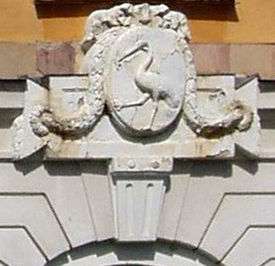Grill (family)
|
The Grill family coat of arms at the Österbybruk manor | |
| Ethnicity | Swedish |
|---|---|
| Place of origin | Genoa, Italy |
| Members |
|
| Distinctions | Prominent in trade, manufacturing and politics |
| Estate | Numerous during the 18th century and 19th century |
| Motto: Honesty is the best policy. | |

The Grill family was one of several Swedish families having significant influence with the Swedish East India Company (SOIC). During the 17th century, 18th century and for some years into the 19th century, they owned ironworks and mills manufacturing goods for export while operating wharfs, textile companies, saw mills and other factories related to shipbuilding. Several Grills were directors of the SOIC and the Grill firm traded with the merchants in Canton (now known as Guangzhou) as members of the SOIC and privately. The Grills owned houses, manors and estates at a number of locations in Sweden.
All the noted Grills were in some way connected to the main Grill Trading House, and several other companies were established in association with the Trading House. The Grill name was kept and passed on through the generations and some of the Grills even shared the same first name.
Apart from the SOIC, the Grills are most noted for their contribution to the Swedish iron industry and for exports of iron during the 18th century.
Origin
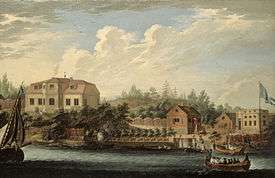
Originating in Genoa, Italy,[3] part of the family moved to Augsburg, Germany where on 29 July 1571, Andreas Grill received burgher arms with their own coat of arms.[4][5] from the Holy Roman Empire.
The name Grill comes from the Italian Grillo, meaning cricket, while the family's coat of arms displays a crane holding a cricket in its beak.[lower-alpha 2]
The family came to Sweden with the arrival of the silversmith Anthoni Grill (I), grandson of Andreas Grill, born in Augsburg and from 1638, a burgess in Amsterdam. He was the Riksguardie (National Appraiser) for the Myntverket in 1658 to 1667, where he supervised the making of coins and made sure that measurements were standardized throughout Sweden. He was not especially good at his work and in 1663, he was demoted to handle smaller goods in gold and silver. He was succeeded at the Myntverket by his son Anthoni Grill (II), who also bought the Grill house at Stortorget in Stockholm.[7]
During the 18th century the family was described as members of the Skeppsbroadeln (the Skeppsbro Nobility).[8] The name was coined during the 18th century and referred to the wealthiest merchant families in Stockholm at that time, especially those who lived by the quays along the Skeppsbron.[9]
The family consisted of two branches —the Garphyttan branch and the Godegård branch. The Grill family is included in the Ointroducerad Adels Förening (Association of the Unintroduced Nobility), an association for Swedish citizens whose family was ennobled in a foreign country, as well as some families who were ennobled in Sweden but for some reason never introduced at the Swedish House of Nobility.[10]
Family tree
A section of the Grill family tree showing some noted members.[7]
Numbers attached to some of the names do not form an official part of their name but are provided as a convenient way of referring to identically named Grills.
| Family of Grill (family) | |||||||||||||||||||||||||||||||||||||||||||||||||||||||||||||||||||||||||||||||||||||||||||||||||||||||||||||||||||||||||||||||||||||||||||||||||||||||||||||||||||||||||||||||||||||||||||||||||||||||||||||||||||||||||||||||||||||||||||||||||||||||||||||||||||||||||||||||||||||||||||||||||||||||||||||||||||||||||||||||||||||||||||||||||||||||||||||||||||||||||||||||||||||||||||||||||||||||||||||||||||||||||||||||||||||||||||||||||||||||||||||||||||||||||||||||||||||
|---|---|---|---|---|---|---|---|---|---|---|---|---|---|---|---|---|---|---|---|---|---|---|---|---|---|---|---|---|---|---|---|---|---|---|---|---|---|---|---|---|---|---|---|---|---|---|---|---|---|---|---|---|---|---|---|---|---|---|---|---|---|---|---|---|---|---|---|---|---|---|---|---|---|---|---|---|---|---|---|---|---|---|---|---|---|---|---|---|---|---|---|---|---|---|---|---|---|---|---|---|---|---|---|---|---|---|---|---|---|---|---|---|---|---|---|---|---|---|---|---|---|---|---|---|---|---|---|---|---|---|---|---|---|---|---|---|---|---|---|---|---|---|---|---|---|---|---|---|---|---|---|---|---|---|---|---|---|---|---|---|---|---|---|---|---|---|---|---|---|---|---|---|---|---|---|---|---|---|---|---|---|---|---|---|---|---|---|---|---|---|---|---|---|---|---|---|---|---|---|---|---|---|---|---|---|---|---|---|---|---|---|---|---|---|---|---|---|---|---|---|---|---|---|---|---|---|---|---|---|---|---|---|---|---|---|---|---|---|---|---|---|---|---|---|---|---|---|---|---|---|---|---|---|---|---|---|---|---|---|---|---|---|---|---|---|---|---|---|---|---|---|---|---|---|---|---|---|---|---|---|---|---|---|---|---|---|---|---|---|---|---|---|---|---|---|---|---|---|---|---|---|---|---|---|---|---|---|---|---|---|---|---|---|---|---|---|---|---|---|---|---|---|---|---|---|---|---|---|---|---|---|---|---|---|---|---|---|---|---|---|---|---|---|---|---|---|---|---|---|---|---|---|---|---|---|---|---|---|---|---|---|---|---|---|---|---|---|---|---|---|---|---|---|---|---|---|---|---|---|---|---|---|---|---|---|---|---|---|---|---|---|---|---|---|---|---|---|---|---|---|---|---|---|---|---|---|---|---|---|---|---|---|---|---|---|---|---|---|---|---|---|---|---|---|---|---|---|---|---|---|---|---|---|---|---|---|---|---|---|---|---|---|---|---|---|---|---|---|---|---|---|---|---|---|---|---|---|---|---|---|---|---|---|---|---|---|---|---|---|
| |||||||||||||||||||||||||||||||||||||||||||||||||||||||||||||||||||||||||||||||||||||||||||||||||||||||||||||||||||||||||||||||||||||||||||||||||||||||||||||||||||||||||||||||||||||||||||||||||||||||||||||||||||||||||||||||||||||||||||||||||||||||||||||||||||||||||||||||||||||||||||||||||||||||||||||||||||||||||||||||||||||||||||||||||||||||||||||||||||||||||||||||||||||||||||||||||||||||||||||||||||||||||||||||||||||||||||||||||||||||||||||||||||||||||||||||||||||
| Notes:
| |||||||||||||||||||||||||||||||||||||||||||||||||||||||||||||||||||||||||||||||||||||||||||||||||||||||||||||||||||||||||||||||||||||||||||||||||||||||||||||||||||||||||||||||||||||||||||||||||||||||||||||||||||||||||||||||||||||||||||||||||||||||||||||||||||||||||||||||||||||||||||||||||||||||||||||||||||||||||||||||||||||||||||||||||||||||||||||||||||||||||||||||||||||||||||||||||||||||||||||||||||||||||||||||||||||||||||||||||||||||||||||||||||||||||||||||||||||
Abraham Grill (I) the Elder
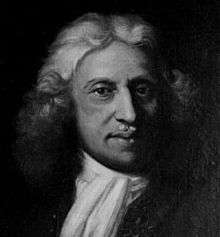
Abraham Grill (1674 – 20 March 1725) was a Swedish merchant. Married three times, he had seven children[3] and was the son of Anthoni (II) as well as heir to the Grill family fortune, which he increased through trade speculation. During the Great Northern War led by King Charles XII, he gave large sums of money to the state and during a time of famine he sold grains at reduced price to the needy. He was also the driving force behind the founding of a house for poor elderly widows in Stockholm on 14 July 1724.[11]
In 1716, he and his brother Carlos Grill, founded the Grill Trading House. The house traded mainly in wrought iron and became one of the leading trading houses in Stockholm during the 18th century.[12] During its first year the company bought reclaimed land, from the Countess Elisabeth Oxenstierna, in the east part of Stockholm. The land was used to establish the Terra Nova Wharf,[lower-alpha 3] also known as the Köpmannavarvet (the Merchants Wharf),[14] where a number of the ships for the SOIC were built.[13]
When Abraham died in 1725, his share of the Trading House went to his son Claes (I). At the death of Carlos in 1736, Claes (I) was sole owner of the company until his half-brother Johan Abraham joined him as partner. Johan Abraham continued to run the Trading House after Claes (I)'s death in 1767. In 1799, Johan Abraham died and the company went bankrupt.[12]
Abraham Grill (II) the Younger
Abraham Grill (28 January 1707 – 28 January 1768) was the brother of Anthoni (III) and Claes (I), and half-brother to Johan Abraham.[3] He started his career as Swedish consul in Helsingør in 1733 to 1736.[7] During his time in Denmark he met Anna Maria Petersen, and they were married in 1735. They had thirteen children of which five died at an early age.[3]
Abraham and his family moved to Gothenburg in 1746, where he established a trading house. That year, he was also one of the directors for the SOIC during the second charter.[15] He cooperated closely with the two other trading houses in the Grill family at that time: Carlos & Claes Grill in Stockholm and Anthony & Johannes Grill in Amsterdam. Abraham's trading house handled most of the copper exported from Gothenburg during a few years in the 1760s. The company also exported iron and tea, brought to Gothenburg by the SOIC.[8]
One of Abraham's many children, Lorentz Grill, became his partner in the trading house in 1761. At the death of Abraham (on his birthday) in 1768, Lorentz sought out new partners and continued running the company.[8]
Johan Abraham Grill

Johan Abraham Grill (1719 – 16 March 1799) was a Swedish merchant and politician. He was the son of Abraham (I), the Elder, and Katarina Rozelius, half-brother to Claes (I) and uncle to Jean Abraham.[11] He married Christina Elisabeth Fischer (1731–1805). It was Johan Abraham who introduced a motto for the Grill family: Ärlighet warar längst (Honesty is the best policy.).[3]
In 1747, Johan Abraham became partner in the Grill Trading House. Throughout his career he held a number of official positions and received several awards. In 1763, he became a board member in the Jernkontoret (The Iron Trade Assiciation), established in 1747, it is the oldest trade association in Sweden.[16] In 1767, he was a member of the Sjöförsäkringsrätten (The Naval Insurance Court) where he handled disputes related to shipping that could not be settled in any other way.[17] With the third charter, he became director of the SOIC in 1770.[18] At the same time he was an accountant and also responsible for credits and loans issued from the Swedish State to various companies.[11][19]
Johan Abraham was a member of the hat party and helped finance the Swedish court and the hats activity in the Riksdag 1771–72, especially in connection to King Gustav III's coup d'état on 19 August 1772, whereby the king's power was solidified.[20] The money for the coup had to be smuggled out from the Grill House in Stockholm, to the Royal castle in double bottom, wooden troughs filled with mortar.[16]
Anthoni Grill (III)
Anthoni Grill (19 April 1705 – 22 March 1783) was the twin brother to Claes (I), he was married to Alida Jacoba Hilke with whom he had four children.[3] He lived in Amsterdam where he, and his brother Johannes, owned the Antoni Grill & Sons Trading House. In 1773, he became owner of the Garphyttan factories when the previous owner failed to repay the money he had borrowed from Anthoni (III).[21] To be able to manage the factories, Anthoni (III), and his family, moved to Stockholm where he lived until his death in 1783.[7]
Claes Grill (I)
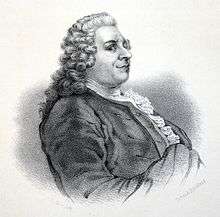
Claes Grill (19 April 1705 – 6 November 1767) was a Swedish merchant and factory owner. Claes was the son of Abraham (I) Grill and Helena Wittmark and twin brother to Anthoni Grill. Claes married his uncle's daughter, Anna Johanna (I) Grill (1720–1778), a woman famed for her beauty. They had two children, a daughter named Anna Johanna (II) 1745–1801) and Adolf Ulric.[3]
Early years
Claes started to work for his father and at the age of 17 when he was employed at Abrahams office in the Grill Trading House. After the death of Abraham (I), Claes became director of the Trading House, and ran the company together with his uncle Carlos. The name of the company was changed to Carlos & Claes Grill, at that time one of the largest trading company in Sweden. After the death of Carlos in 1736, he was sole head of the firm until 1747, when his half-brother joined him as partner.[16] Since the family had connections to the Netherlands, Claes went there in 1731 or 1732, to further his education and gain more experience with the trading business.[22]
The Grill Trading House
During the mid 18th century, the Grill Trading House flourished both in Sweden and abroad. They were connected to hundreds of trading houses in Europe. Foremost was the export of goods to Hamburg, Amsterdam and England. The Dutch Grill company, Antoni Grill & Sons based in Amsterdam acted as a centre for payments to the Grill trading house in Stockholm. The Anglo-Swedish company run by Andrew & Charles Lindegren in London handled all the exports, shipping documents, vessel clearances, and insurance for the Grill Trading House. They also supplied Swedish ships with transit cargoes from England to the countries around the Mediterranean Sea.[22]
During the second charter of the SOIC between 1746 and 1766, the Grill Trading House was one of the leading companies in the East India trade. They were partners in a large linen and rigging factory as well as a glass factory in Stockholm. They leased the Stora Stads wharf in Stockholm, owned the Terra Nova wharf and had interests in the Djurgården wharf. All three wharfs built ships for both the SOIC and foreign customers.[23]
The Grill Trading House also ran a banking business for Swedes traveling abroad. Since the company was connected to so many other trading houses, they could issue bills of exchange for travelers and diplomats to be redeemed at trading houses in other countries. Under the direction of Claes, the trading house acquired several factories and ironworks: Söderfors 1748, Österbybruk with the Dannemora mine (1750) and Iggesund (1753). The main exports from these factories were iron, copper, lumber and tar. Imports consisted of salt from Portugal, oak and hemp from the Baltic states, also wine, coffee, sugar, cheese, tobacco and textiles.[10] Claes ran his companies in an old-fashioned, patriarchal way writing letters every week to his managers at the estates concerning everything from the running of the factories to making enquiries about individual employees. Overall, the Grills industrial companies employed more than 4,000 persons at that time.[22]
Houses and estates

With the building of the manor in Österbybruk, it became the hub for all the iron and mining activities of the Grill Trading House, although Claes and his family did not live there permanently. They lived in the Grill house in Stockholm until 1764, when he bought the Torstensonska Palace (now known as the Arvfurstens palats) at Gustav Adolfs torg, Stockholm. The summers were spent at Svindersvik, a country residence outside Stockholm, built by Claes in the early 1740s.[22]
Claes was an art collector and his houses were decorated with Chinese objects as well as paintings by Swedish and Dutch masters like Alexander Roslin, Gustaf Lundberg, Hans Memling and David Teniers. He owned six complete sets of porcelain tableware commissioned from Canton. As of 2014, the oldest and largest of these still has 325 pieces preserved.[22] Imported porcelain broken in transit from China or by daily household use became decorative gravel used on the garden paths at one of the Grills' estates. This example of wasting money and resources was condemned by those who opposed the activities of the SOIC. Even noted botanist Carl Linnaeus was at first an opponent. He wrote: "A part of the silver, which withstands the wear and tear of time and which even fire cannot destroy, we exchange for fragile objects of clay, which, once dropped, cannot be mended."[24]
Benefactor
Claes was interested in natural science and contributed to different projects, such as helping Carl Linnaeus financially and with the collection of plants and animal specimens from foreign lands. In 1740, he became a member of the Royal Swedish Academy of Sciences. He gave financial support to young scientists and naturalists, lent money (without interest) to the Royal Swedish Academy of Sciences for the construction of an observatory, contributed a substantial sum of money to the Danviken Hospital and saved the Sveriges Riksbank (the central bank of Sweden) from bankruptcy in 1747 by buying banknotes at their nominal value. In 1748, he became preses or president of the Royal Academy of Sciences and was elected to the board of directors at the central bank of Sweden, a position he held until 1756.[lower-alpha 4] Claes was also awarded the honorary title of kommerseråd ("trade counselor") by King Adolf Frederick. In 1755, he was one of the initiating founders of the Factory Academy, a social network for factory owners in central Sweden.[16]
Political life and fall
Between 1748 and 1750, Claes was a member of the Bourgeoisie in the Riksdag of the Estates and politically involved with the Hats. He was also one of the partners in the infamous Växelkontoret (Exchange office), a private financial institution handling mainly promissory notes without the involvement of the central bank. When the Caps became the ruling party in 1765, Claes, along with his half-brother Johan Abraham and all the other members of the Växelkontoret, were accused of corruption and mishandling its affairs. In 1765, Claes and Johan Abraham, were fined by the Justice deputation of the Riksdag, and in 1766, they were sentenced to pay back "five barrels of gold" to the Växelkontoret. When the Hats regained their political power in the Riksdag the following year, the sentence was revoked, but by then Claes had died.[16]
Jean Abraham Grill
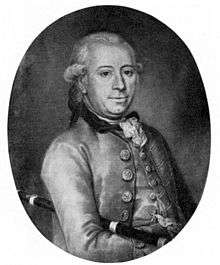
Jean Abraham Grill (21 July 1736 – 12 March 1792), sometimes called Johan Abraham Grill, was a Swedish merchant, supercargo and director of the SOIC as well as an ironmaster. Jean Abraham was the oldest son of merchant Abraham (II), and Anna Maria Petersen.[26]
He journeyed to China twice, was shipwrecked the second time,[27] and lived in Canton as well as Macao for almost ten years. He was the representative in Canton for the SOIC, buying goods for the company during the arrival of three ships, plus the shipwrecked Fredric Adolph.[28] He also had two trading companies, one together with Michael Grubb,[29] trading with the countries close to China, and one of his own, which he used for trading tea and smuggling opium from India to China.[30]
When he returned to Sweden, he bought the Godegård ironworks and manor, along with several other ironworks, that he renovated and improved.[31][26] All his notes, correspondence, accounts, cargo lists and books are preserved in the Godegård Archive.[32]
Claes Grill (II)

Claes Grill (2 September 1750 – 2 August 1816) was a Swedish merchant. He was the son of Abraham Grill (II) the Younger. In 1770, he settled down in London, where he met and married Maria Hackson. They had three children.[3]
In 1770, Claes became partner in the Anglo-Swedish company Andrew & Charles Lindegren, a London-based importer of Swedish iron. Andrew & Charles Lindegren traded with the Carlos & Claes Grill (the Grill Trading House) and was the major supplier of iron to the British East India Company.[33] The name of the company was changed first to Lindegren & Grill, and later to Lindegren son & Grill. By that name, the company continued to serve as an agent for the East India Company in Portsmouth.[8]
Claes became Counsel General to London in 1786 to 1815,[8] Both he and William Chalmers applied for that position, but Claes was better known in the London society, had lived longer in England and was connected to a large trading house. By the time he died in Chelsea in 1816, Claes was also partners with a merchant, Harrison, in London.[34]
Jacob Grill
Jacob Grill (1734 – 1799) was a Swedish ironworks owner. He was born in Amsterdam, the son of Anthoni Grill (III). He never married and had no children.[3]
Jacob moved to Sweden with his father and his brothers when his father became owner of the Garphyttan ironworks.[7] In 1769, Jacob became the owner of the Skebo and Ortala ironworks, the Norrtälje gun factory and the Männäis blast furnace in Nykyrka, Åbo, when the previous owner was forced to sell due to financial difficulties.[35] During his time at Skebo, Jacob built the Skebo Manor in 1767 to 1770.[36] He was very inexperienced in how to operate the ironworks, and they gradually became the property of his lender, the Tottie & Arfwedson Trading House, and in 1782, the transfer was complete. Jacob moved to Broby, then Graneberg and finally to Nyköping where he died penniless.[35]
Adolf Ulric Grill
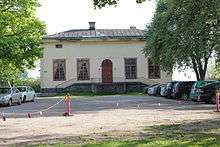
Adolf (Adolph) Ulric Grill (19 March 1752 – 1 October 1797) was a Swedish ironworks owner and scientific collector of animals and fossils for his cabinet of curiosities at Söderfors. He married his cousin, Anna Johanna (III) (1753–1809) in Stockholm on 7 June 1778, they had one son who died at an early age. At the time of his marriage, Adolf Ulric lived in the Grill house in Stockholm. He and his wife moved to Söderfors when he inherited the ironworks and manor from his father Claes (I) in 1767.[37]
Ironworks owner
Adolf Ulric was a dedicated and hands-on owner of the ironworks at Söderfors, who supervised the operation and managed the books. Initially the factory's main products were anchors but with additions and improvements to the facilities he expanded into the production of wrought and pig iron amongst other goods. The products from the ironworks were of good quality and production peaked in 1780.[38]
Collector
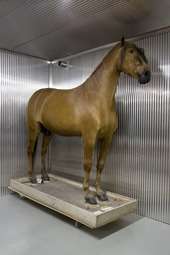
Like his father, he was a natural scientist and he collected mounted animals, fossils, minerals and plants in a museum, started in 1783, at the Söderfors manor. The first specimens were collected in the vicinity of Söderfors. After two years Adolf Ulric moved on to the birds of the archipelago. He was able to use his connections through his relatives in the trading houses, to send for specimens from Greenland and China. The collections were also increased during his travels and on a journey to England in 1788, he traded a mounted moose for 60 rare birds.[37]
In 1786, Adolf Ulric built a separate house at the manor for the zoological collection. At that time it contained 116 mounted mammals, 600 birds, 700 seashells and 39 fishes. The collection was displayed as a full size diorama, the centerpiece being a cliff with mounted lions, tigers with cubs, leopards and a number of other animals surrounding the cliff, the largest being a sirenia. The museum was the largest collection in the Nordic countries at that time, it also received some international recognition. In 1793, Adolf Ulric became a member, and preses in 1795, of the Royal Swedish Academy of Sciences for his work with the museum. In 1828, the collection was donated to the Academy by the Grill family.[37] As a tribute to him, the giant oarfish (Gymnetrus Grillii),[lower-alpha 5] was named after him.[11]
Builder
Adolf Ulric paid for the building of a church in Söderfors that was inaugurated on 30 September 1792.[37] Three years later, at a time of crop failure and famine in Söderfors, he started the construction of an English garden at the manor to provide jobs for the farmers in Söderfors and the neighboring Hedesunda socken. As a result, the park, a main feature in Söderfors, is sometimes called the Hedesunda brödkaka (the Hedesunda bread biscuit). Since 1998, the park has been included in the listed buildings of Söderfors.[40]
Adolf Ulric was known as a music lover and amateur composer. Wherever he lived, he organized well attended concert nights, with musicians invited from Stockholm.[37] In 1772, he became a member of the Royal Swedish Academy of Music.[41]
Estates, mansions and factories
These are some of the estates and factories owned by members of the Grill family or by the Grill Trading House during the 18th and 19th century.[42]
The Grill house, Stockholm
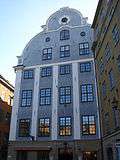
The Grill House at Stortorget 3 in Gamla stan, Stockholm was built during the Middle Ages and thoroughly converted in 1649. Although subsequently remodeled in 1750 and 1914, the large molded baroque gable and some of the painted joists date to the 17th century conversion. The classic lesene of the facade and some of the interior are from the mid 18th century. It acquired its name in the 17th century when the house was purchased by Anthoni Grill (II).[7] The Grill family owned the house for more than two hundred years and as of 2013, it houses the Stockholms Stadsmission (The Stockholm City Mission).[42][43]
The Grill mansion, Uppsala

The Grill family (possibly Claes Grill (I)) started to build the Grill manor in central Uppsala after the great fire in 1766. At the time, the family owned ironworks at Söderfors and Österby in Uppland, as well as at Iggesund in Hälsingland. The estate was completed in 1770. The Grill family owned the manor until 1790. It is the only preserved town manor in Uppsala. As of 2013, it houses apartments and offices for the Red cross and Save the Children.[44][45]
The Lennart Torstensons palace

Claes Grill (I) bought the palace in 1764, and lived there until he died in 1767, after which it was passed on to his wife Anna Johanna (I), and later their daughter Anna Johanna (II). In 1783, it was bought by Princess Sophia Albertina and converted into a part of the Arvfurstens palats.[46] As of 1906 it houses the Swedish Ministry for Foreign Affairs.[47]
Svindersvik
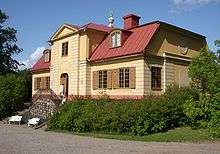
Built by Claes Grill (I), the residence was designed by architect Carl Hårleman in the early 1740s. It is one of Sweden's oldest preserved country residences. Claes and his wife Anna Johanna (I), would live in Stockholm during the winter and spend the summers at Svindersvik. The residence was usually accessed by rowboat. The style of the residence is rococo, with many Chinese elements brought to Sweden by the SOIC. At the death of Claes (I), the estate was passed on to his daughter Anna Johanna (II). The house was sold in 1780, and passed through several owners, until it was bought by silk manufacturer K.A. Almgren in 1863. As of 1949, the house is owned by the Nordic Museum.[48]
Söderfors


The Grill's estate in Söderfors largely made up the entire town at that time along with the ironworks and the manor. The ironworks were founded in 1676 to make anchors. Claes Grill (I) bought the ironworks in 1748, and it stayed within the Grill family until 1907.[38] The factory passed through several owners and is, since 1995, owned and operated by Scana Steel Söderfors AB, a company with production in Norway, Sweden and China.[49]
The first manor was finished in 1700 then between 1749 and 1756 it was rebuilt by architect Carl Hårleman for Claes Grill (I). After his death, the manor passed to his son Adolf Ulric. He was an avid naturalist and during his redidence he filled it with art and specimens of mounted animals, minerals, fossils and plants.[38] Adolph Ulric had a separate house built for his collection in 1786. He also started the construction of an English garden at Söderfors by the river Dalälven. Gustaf af Sillén completed the park, which is one of the main features in Söderfors.[40] As of 2014, the manor is a hotel and conference venue. On 20 December 1985, most of the ironworks and the surrounding area of Söderfors, a total of 91 buildings, became listed buildings, making it one of the largest listed sites in Sweden.[50] [51]
Österbybruk


The ironworks at Österbybruk were established by King Gustav I of Sweden with the help of German experts during the 16th century and specialised in making munitions. During the 17th century the factories were merged with Lövsta and Gimo, under the directions of Louis De Geer, making it the second largest ironworks in Sweden.[52] Since De Geer recruited skilled iron workers from the Walloon Region of Belgium, these ironworks became known as the Walloon factories ("Wallonbruken").[53] The iron ore processed in Österby came from the Dannemora mine and was noted for its purity. Iron bars produced at these ironworks were stamped with a "Double Bullet" mark, which guaranteed high and consistent quality. Such iron became reputable in England, where it was used by the steel industry in Sheffield.[22] In 1758, the ironworks was sold to the Grill Trading house, at that time owned by Claes (I) and Johan Abraham. The trading house was discontinued with the death of Johan Abraham in 1799, and the ironworks was sold to Anna Johanna (III), the wife of Adolf Ulric.[54] The factory passed through several owners until it was closed in 1983.[55]
In 1763, Claes (I) started construction of the mansion at Österbybruk. The mansion incorporated the two wings already built in the 1730s; the west wing which served as housing for one of the ironworks caretakers and the east wing containing a chapel. The mansion was not completed until 1780, due to the decline of the East India trade, accusations of financial misconduct against Claes and Johan Abraham and the banking crises in Amsterdam in 1763.[56] As of 2014, the manor is owned by the Bruno Liljefors Foundation. His studio in one of the buildings is preserved and is on occasion open to the public.[53]
Iggesunds bruk
The ironworks at Iggesund is predated by a sawmill established by the Swedish state in 1572. The first ironworks were established in 1685, by the trader Isak Breant, the Elder. It included a blast furnace, a forge with a trip hammer and two finery forges. The iron ore came from Utö and the Dannemora mine.[57] After the Russians burned Iggesund down during raids along the Swedish coastline in 1721, the ironworks was bought by the Grill Trading House. The Grills successfully ran and improved the factories during most of the 18th century.[58] With the decline of the Trading House in 1800, the ironworks went through several owners until it was sold to the owners of Österbybruk at that time. During the 20th century the ironworks were, through several owners, transformed and diversified into a sawmill, pulp and paper industry, chemical plant, dairy and agricultural companies. As of 1988, Iggesunds bruk is a part of Iggesund Paperboard.[57]
Godegård


The Grill's estates at the village of Godegård, the manor and the ironworks, dominated the community during the 18th century. Mining had been done in the area as early as in the Middle Ages, and by the early 17th century, an ironworks was already established at Godegård. The ironworks was bought by Louis De Geer in 1618. He improved and expanded the factories and recruited skilled Walloons iron workers to teach the Swedes how to use a finery forge.[59] When he died, the ironworks and the first manor passed on to his son Jean De Geer. After a fire in 1719, the new manor was built. It was completed in 1725.[60]
Settling down in Sweden after his profitable journeys to China, Jean Abraham was looking for something to invest in. He started negotiations for the purchase of land, manor and factory at Godegård, at that time the largest ironworks in Östergötland, and bought them all in 1775.[26] Jean Abraham continued the expansion of the ironworks and made significant restoration of the manor. He also built an English garden, designed by Fredrik Magnus Piper, with several gazebos in a Chinese style.[59] The ironworks was closed in 1896, but the manor remained in the Grill family until 1980. It became a listed building in 1977.[61] Jean Abraham collected all of his letters, accounts and notes in an archive at Godegård, now known as the Godegård Archive. As of 2003, the archive, containing over 7,000 document, is in the Nordic Museum. It has been digitized and is available on line as result of a request from the Macau Historical Archives in 2003.[32]
Mariedamm
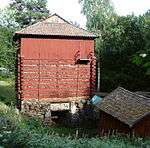
The Trehörnings blast furnace in Mariedamm was originally built by local miners in 1636. Louis De Geer bought it in 1648, and it became part of the Godegårds ironworks which was sold on to Jean Abraham in 1775. The blast furnace remained a part of the Grill's estate at Godegård until 1888, when it was sold to the Skyllbergs bruk. The blast furnace was in operation until 1889. Since 1923, it is in being cared for and renovated by the Lerbäck Heritage society.[62] At the beginning of the 19th century, a mansion was built in Mariedamm by the Grill family. The mansion was demolished in the 1920s, only one of the wings remain.[63]
Garphyttan

The mining at Garphyttan was started during the Middle Ages by German miners. These were called "garps", a medieval Swedish word meaning "loudmouths" or "braggers".[64] The main product was lead ore which also contained silver, but the yield from the ore was small and business faltered a number of times during the 17th century and early 18th century. It was not until the factory was bought by three Dutch merchants in 1661, that the company started to flourish again. A trip hammer, two hearths, a smithy, a saw mill, a silver refinery and housing for the workers were added. The factories and the ironworks went through several owners until 1773, when Abraham (III) acquired them all. The previous owner had borrowed money from the Anthony Grill & Sons Trading House in Amsterdam, and when he failed to repay the loan, the factories became the property of the Grills. The building of a manor at Garphyttan started during the 17th century, and several additions were made in the middle of the 18th century. The main building of the manor was destroyed during a fire in 1830, only the four wings remain.[21]
Stora Nyckelviken

Stora Nyckelviken manor was completed in 1746 by Herman Petersen, a wealthy merchant and director of the SOIC. The manor was designed in much the same style as the other manors built with the profits from the East India trade. It consists of a main building, wings, gazebos and a park. The manor was only owned by the Grill family for a short period of time. Jean Abraham Grill bought it in 1760, and sold it 20 years later.[42] As of 2014 the manor is owned by the municipality of Nacka. It houses a restaurant and a conference venue.[65]
Skebo and Ortala

The first ironworks in Skebo was built in the 15th century. The iron ore was mined locally in the forests surrounding the factory. The first smithy with a trip hammer at Skebo, was constructed by Hindrich Lemmens in 1626. The iron from the ironworks was mainly sold to the Norrtälje rifle factory, which made weapons used in the Thirty Years' War. During the 18th century the Skebo and Ortala (a similar mine and factory nearby) ironworks were operated jointly. They went through several owners, due to the economical entanglements and financial difficulties of the directors and investors. One of these affairs resulted in Jacob Grill obtaining Skebo and Ortala, along with three other factories in 1769, from the previous owner who could not pay his debt to Jacob.[42] Jacob had no experience in operating an ironworks, he got into financial difficulties and had to sell the factories in 1782. The ironworks flourished during the 19th century, and began to decline after 1900, ending in bankruptcy in 1924.[36]
During his time at Skebo, Jacob built a manor in 1767–1770. During the 19th century the new owners filled it with art and sculptures and it became a center for the local socialite. When the ironworks folded the manor became a retirement home for elderly gentlemen, a spa, a house for seminars and workshops, and in 2010, a noted restaurant listed in the White Guide 2012.[66] As of 2013, the restaurant is closed and the manor is a temporary lodging for refugees seeking asylum in Sweden.[67]
The Lövåsen lead and silver factory

The Lövåsen lead and silver factory in Stora Skedvi was one of the first factories to be connected with the Grill family. The Swedish government handed over the administration of the factory to Anthoni Grill (I) in 1656, to be used as a laboratory and workshop by him. He had claimed that he was in possession of a secret "matter" that would enable him to extract much more copper, lead, silver and gold from the ore than by other conventional methods. He experimented fore some years at the laboratory, but he never improved the extraction process, and was consequently demoted from his position at the mine. As of 2014, there are no visible remains of the mine or the factory.[7]
Ersta

Ersta is one of the many malmgårdarna (suburban manors) built in Stockholm during the 17th and 18th century. At these manors, wealthy, noble families from different parts of Sweden, could enjoy the same comforts as in their homes in the country. The manors were built in the suburbs, close to what constituted Stockholm in the 17th century and 18th century. The city has grown considerably since then, and these locations are now considered to be part of central Stockholm. Many of the buildings, the entire manor or part of them, are still in use and embedded in the modern cityscape.[68]
Ersta, on the high cliffs of southern Stockholm, was probably built in the 1670s by brännvin manufacturer Oluf Håkansson. At that time the land in that area was cheap since it was close to the old gallows. When the gallows was moved further away from town to make way for a new shipyard, the Stora Stads wharf, where ships for the SOIC were built, the area around Ersta became sought after and was called "a garden". The mansion passed through several owners until Jean Abraham Grill bought it in 1755. In 1770, he established a crucible steel factory at Ersta with the help of Bengt Andersson Qvist, a member of the Swedish Board of Mines. Members of the Qvist family were inspectors at the Iggesund ironworks.[42] The steel was of good quality, but nevertheless unprofitable. In 1775, Jean Abraham sold the manor and the steel factory to Qvist who ran the company until it folded with his death in 1799.[69] As of 2014, only two of the buildings at the manor remain. They are a part of the Ersta Hospital and one of them houses the Ersta museum.[70]
Notes
- ↑ The swallow-tailed version of the Swedish flag was used on the ships of the SOIC even though the use of such a flag was prohibited. Only ships in the Swedish Navy were entitled to fly a (triple-)tailed flag. The SOIC ships used the two-tailed version, that looked like a navy flag, to discourage pirates at sea. Despite the prohibition, Claes Grill (I) ordered several flags in Canton.[1] He even used them at his summer residence, Svindersvik, on land and on the rowboat taking him to and from the house. One of these flags remained at Svindersvik and is one of the oldest, preserved flags in Sweden. As of 2014 it is kept at the Livrustkammaren.[2]
- ↑ Shield:Or, standing on a triple mount sable, a crane holding a cricket on its beak proper.[6]
- ↑ Terra Nova is Latin for "new land" and refers to the reclaimed land it was built upon.[13]
- ↑ In his speech at the Academy on 4 February 1749, Claes (I) spoke on the use of shipping. In his speech he summed up the ships owned by shipping companies in Stockholm in 1749: "Ships made of oak: 62 ships up to and including 100 lästs, 16 ships up to 200 lästs, 4 ships up to 300 lästs. Ships made of pine: 63 ships up to and including 100 lästs, 31 ships up to 200 lästs, 13 ships up to 300 lästs and 3 over 300 lästs." [25]
- ↑ The name was given in 1798, and has since been altered to Regalecus glesne.[39]
References
- ↑ Kjellberg 1975, pp. 174–176.
- ↑ Söderberg, Bengt G. (1968). Slott och herresäten i Sverige. Södermanland. [Castles and manors in Sweden. Södermanland] (in Swedish). Malmö: Allhems förlag. pp. 170–171. LIBRIS 483512.
- 1 2 3 4 5 6 7 8 9 Grill, Johan Wilhelm; Grillo Ankarswärd, Karl (1951). Conceptbok till Grillska släktens historia [The Grill family history] (PDF) (in Swedish). Godegård: Mårten Persson. Retrieved 20 August 2014.
- ↑ "En praktfull ostindisk servis med det grillska vapnet" [A splendid East India tableware with the Grill coat of arms]. www.digitaltmuseum.se. Digitalt Museum—Nordic Museum. Retrieved 27 July 2014.
- ↑ "Grilliana – En sida om släkten Grill" [Grillology – A page about the Grill family]. www.grilliana.wordpress.com. The Grill family. Retrieved 27 July 2014.
- 1 2 Schöldström, Birger (1879). "Ett fosterländskt Bildergalleri." [A patriotic picture gallery.]. Svenska Familj-Journalen (in Swedish). Stockholm: Svenska Familj-Journalen via Project Runeberg. 18: 325–327.
- 1 2 3 4 5 6 7 "Grill, släkt" [Grill, family]. Svenskt biografiskt lexikon (in Swedish). 17. Stockholm: National Archives of Sweden. 1967–1969. p. 276.
- 1 2 3 4 5 Svensson, Anders. "Abraham Grill". http://gamlagoteborg.se/. Det Gamla Göteborg. Retrieved 14 September 2014. External link in
|website=(help) - ↑ "Skeppsbroadeln" [Skeppsbro nobility]. www.ne.se (in Swedish). Nationalencyklopedin. Retrieved 16 September 2014.
- 1 2 Müller, Leos (1998). The merchant houses of Stockholm, c. 1640–1800: a comparative study of early-modern entrepreneurial behaviour. Studia historica Upsaliensia, 0081-6531 ; 188Studia historica Upsaliensia, 0081-6531 ; 188. Uppsala: Acta Universitatis Upsaliensis. ISBN 91-554-4233-1. LIBRIS 8359550.
- 1 2 3 4 Meijer Bernhard; Westrin Theodor; Berg Ruben G:son; Söderberg Verner; Fahlstedt Eugène, eds. (1909). "Grill". Nordisk familjebok–Uggleupplagan (in Swedish). Stockholm: Nordisk familjeboks förl. pp. 303–304.
- 1 2 "Handelshuset Carlos & Claes Grill (1716–1799)" [The Carlos & Claes Grill Trading House (1716–1799)]. www.riksarkivet.se/. National Archives of Sweden. Retrieved 14 September 2014.
- 1 2 Zethelius 1956, p. 59.
- ↑ "Strandvägshamnen" [Port at Strandvägen]. www.stockholmshamnar.se. Stockholms Hamn. Retrieved 14 September 2014.
- ↑ Kjellberg 1975, p. 165.
- 1 2 3 4 5 Hofberg, Herman, ed. (1906). "Grill, Klas". Svenskt biografiskt handlexikon (in Swedish). 1. Stockholm: Svenskt biografiskt handlexikon via Project Runeberg. pp. 402–403. Retrieved 20 August 2014.
- ↑ "Kungl. Sjöförsäkringsöverrätten (1750–1866)" [The Naval Insurance Court (1750–1866]. www.riksarkivet.se/. National Archives of Sweden. Retrieved 12 August 2014.
- ↑ Kjellberg 1975, p. 166.
- ↑ "Generaldiskontkontoret bildades 1787 som..." [The General Credit's Office was established in 1787 as...]. http://svenskuppslagsbok.se/. Svensk uppslagsbok. Retrieved 12 August 2014. External link in
|website=(help) - ↑ Gunnar Carlquist, ed. (1932). "Gustav III". Svensk uppslagsbok. Malmö: Baltiska förl. LIBRIS 1335380.
- 1 2 Nachmanson, August; Hannerberg, David (1945). Garphyttan: ett gammalt bruks historia [Garphyttan: the history of an old orinworks] (in Swedish). Stockholm: Bonnier. LIBRIS 26310.
- 1 2 3 4 5 6 Hildebrand, Bengt; Högberg, Staffan (1967–1969). "Claes Grill". Svenskt biografiskt lexikon (in Swedish). 17. Stockholm: National Archives of Sweden. p. 281. Retrieved 21 September 2014.
- ↑ Kjellberg 1975, p. 131.
- ↑ Roth, Stig (1965). Chinese porcelain: imported by the Swedish East India Company. Göteborg: Historiska Museet. p. 24. LIBRIS 1520976.
- ↑ Zethelius 1956, p. 96.
- 1 2 3 Högberg, Staffan (1967–1969). "Johan Abraham Grill". Svenskt biografiskt lexikon (in Swedish). 17. Stockholm: National Archives of Sweden. p. 285. Retrieved 23 September 2014.
- ↑ Kjellberg 1975, p. 179.
- ↑ Lindqvist 2002, p. 100.
- ↑ "Grubb, släkt" [Grubb, family]. Svenskt biografiskt lexikon (in Swedish). 17. Stockholm: National Archives of Sweden. 1967–1969. p. 341. Retrieved 24 September 2014.
- ↑ Kjellberg 1975, p. 111.
- ↑ Frängsmyr 1990, p. 104.
- 1 2 Gram, Magdalena. "Svenska Ostindiska Kompaniet" [Swedish East India CompanyI]. http://ostindiska.nordiskamuseet.se/. Nordic Museum. Retrieved 25 August 2014. External link in
|website=(help) - ↑ Müller, Leos (2007). Dickson, David; Parmentier, Jan; Ohlmeyer, Jane H, eds. Irish and Scottish mercantile networks in Europe and overseas in the seventeenth and eighteenth centuries. Gent: Academia Press. p. 162. ISBN 90-382-1022-1.
- ↑ Samuelsson, Kurt (1951). De stora köpmanshusen i Stockholm 1730–1815: en studie i den svenska handelskapitalismens historia [The grand trading houses in Stockholm 1730–1815: a study in the history of Swedish trade capitalism] (in Swedish). Stockholm: Ekonomisk-historiska institutet i Stockholm. pp. 46–50. LIBRIS 8074825.
- 1 2 Norrby, Jonas (1991). Jennings (in Swedish). Vällingby: Statens vattenfallverk. ISBN 91-7186-288-9. LIBRIS 7617104.
- 1 2 "Ett av Upplands äldsta järnbruk" [One of the oldest ironworks in Uppland]. www.skebobruksmuseum.se. Skebobruks Museum. Retrieved 28 August 2014.
- 1 2 3 4 5 Sjöberg, Sven (1967–1969). "Adolph Ulric Grill". Svenskt biografiskt lexikon (in Swedish). 17. Stockholm: National Archives of Sweden. p. 288.
- 1 2 3 Fritz Martin, ed. (1976). Söderfors 300 år (in Swedish). Falun: Stora Kopparbergs bergslags AB. pp. 37–49. LIBRIS 129674.
- ↑ Froese, Rainer. "Synonyms of Regalecus glesne Ascanius, 1772". www.fishbase.org. FishBase. Retrieved 19 September 2014.
- 1 2 "Engelska parken i Söderfors bruk." [The English garden at Söderfors.]. www.lansstyrelsen.se. Länsstyrelsen Uppsala län. Retrieved 10 August 2014.
- ↑ Nyström, Pia; Kyhlberg-Boström, Anna; Elmquist, Anne-Marie (1996). Kungl. Musikaliska akademien: matrikel 1771–1995trans_title=The Royal Swedish Academy of Music: members 1771–1995. Kungl. Musikaliska akademiens skriftserie, 0347-5158 ; 84 (in Swedish) (2., rev. och utök. uppl. ed.). Stockholm: Royal Swedish Academy of Music. ISBN 91-85428-99-X. LIBRIS 7749167.
- 1 2 3 4 5 Persson, Mårten. "Några av släkten Grills gods och gårdar." [Some of the Grill's houses and manors.] (PDF). www.grilliana.files.wordpress.com. The Grill family. Retrieved 27 July 2014.
- ↑ Gledin, Ewa. "Om Grillska Huset" [About the Grill house]. www.stadsmissionen.se. Stockholms Stadsmission. Retrieved 27 July 2014.
- ↑ "Kakelugn från 1700-talet i Grillska garden." [A tiled stove from the 1700s in the Grill manor.]. www.digitaltmuseum.se. Digitalt Museum—Upplandsmuseet. Retrieved 27 July 2014.
- ↑ Ehn, Ola (1984). "Grillska gården i Uppsala" [The Grill manor in Uppsala]. Uppsala: Upplandsmuseet. Retrieved 27 July 2014.
- ↑ Ellehag, Claes (1998). Palatsen i Stockholm under stormaktstiden [The Palaces in Stockholm during the Swedish Empire]. Böcker om konst (Signum), 99-0345976-9 (in Swedish). Lund: Signum. pp. 126–128. ISBN 91-87896-38-9. LIBRIS 7767599.
- ↑ "Arvfurstens palats". www.sfv.se. Statens Fastighetsverk. Retrieved 10 August 2014.
- ↑ "A rococo style country residence". www.nordiskamuseet.se. Nordic Museum. Retrieved 10 August 2014.
- ↑ "Scana Steel Söderfors". www.scana.no. Scana. Retrieved 10 August 2014.
- ↑ "Tierp Söderfors bruk". www.bebyggelseregistret.raa.se. Swedish National Heritage Board. Retrieved 10 August 2014.
- ↑ "Welcome to Söderfors Herrgård". www.soderforsherrgard.se. Söderfors Herrgård. Retrieved 10 August 2014.
- ↑ Dahlgren, Erik Wilhelm (1928). De uppländska bruken Österby, Forsmark, Leufsta och Gimo under äldsta tider [The Upplandic ironworks Österby, Forsmark, Leufsta and Gimo during the elder days] (in Swedish). Stockholm. LIBRIS 1488887.
- 1 2 Högström, Leif. "Österbybruk" (PDF). www.vallonbruken.nu. Vallonbruk i Uppland med Länsstyrelsen i Uppsala län. Retrieved 20 August 2014.
- ↑ Tham, Wilhelm (1850). Beskrifning öfver Sveriges rike. Bd 1. H. 3, Beskrifning öfver Upsala län [Description of the land of Sweden. Description of Upsala county] (in Swedish). Stockholm: C. A. Bagge. LIBRIS 387888.
- ↑ "Österbybruk". www.svetur.se. Visit Roslagen. Retrieved 20 August 2014.
- ↑ Hildebrand, Bengt (1967–1969). "Claes Grill". Svenskt biografiskt lexikon (in Swedish). 17. Stockholm: National Archives of Sweden. p. 281.
- 1 2 Klingström, Lars. "Holmen 400 år, 1609–2009". www.holmen.com. Holmen. Retrieved 24 August 2014.
- ↑ "Hudiksvalls bruksminnen". http://www.bruksminnen.com/. The Hudiksvalls Bruksminnen Foundation. Retrieved 24 August 2014. External link in
|website=(help) - 1 2 Ekinge, Robert. "Louis De Geer". www.ekinge.nu. Robert Ekinge. Retrieved 24 August 2014.
- ↑ "Godegård". Nordisk familjebok (in Swedish). 5. Stockholm: Project Runeberg. 1800. pp. 1333–4.
- ↑ "Godegårds säteri". www.bebyggelseregistret.raa.se. Swedish National Heritage Board. Retrieved 25 August 2014.
- ↑ "Trehörnings masugn" [The Trehörnings blast furnace]. www.lansstyrelsen.se. Länsstyrelsen Örebro län. Retrieved 26 August 2014.
- ↑ Persson, Mårten (2007). "Andreas Gustaf Grill – bergsman och entreprenör" [Andreas Gustaf Grill – miner and entrepreneur]. D-dissertation at the history dep. of the Lund university.
- ↑ "Garp". Nordisk familjebok (in Swedish). 9. Stockholm: Project Runeberg. 1908. pp. 764–4.
- ↑ "Stora Nyckelviken". www.stockholmslansmuseum.se. Stockholms läns museum. Retrieved 27 August 2014.
- ↑ "Detta har hänt" [The story so far]. http://skeboherrgard.se/. Skebo Herrgård. Retrieved 28 August 2014. External link in
|website=(help) - ↑ Andersson, Ki. "Skebo herrgård tillfällig bostad för flyktingar" [Skebo manor temporary home for refugees]. http://norrteljetidning.se/. Norrtelje Tidning. Retrieved 28 August 2014. External link in
|website=(help) - ↑ Lindberg, Birgit (1985). Malmgårdarna i Stockholm [The suburban manors of Stockholm]. Stockholm: LiberFörlag. p. 16. ISBN 91-38-90418-7. LIBRIS 7268833.
- ↑ Lindberg, Birgit (1985). Malmgårdarna i Stockholm [Suburban manors of Stockholm]. Stockholm: LiberFörlag. pp. 45–48. ISBN 91-38-90418-7. LIBRIS 7268833.
- ↑ "Hur staden på berget växte fram" [How the city on the mountain came to be]. www.erstadiakoni.se. Ersta diakoni. Retrieved 28 August 2014.
Bibliography
- Frängsmyr, Tore (1990). Ostindiska kompaniet: människorna, äventyret och den ekonomiska drömmen [The Swedish East India company: the people, the adventure and the economic dream] (in Swedish) (2 ed.). Höganäs: Wiken. ISBN 91-7024-653-X. LIBRIS 7591876.
- Lindqvist, Herman (2002). Historien om ostindiefararna [The story of the East Indiamen] (in Swedish). Gothenburg: Hansson & Lundvall. ISBN 91-85023-02-7. LIBRIS 8843398.
- Kjellberg, Sven T. (1975). Svenska ostindiska compagnierna 1731–1813: kryddor, te, porslin, siden [The Swedish East India company 1731–1813: spice, tea, porcelain, silk] (in Swedish) (2 ed.). Malmö: Allhem. ISBN 91-7004-058-3. LIBRIS 107047.
- Zethelius, Gustaf A (1956). "Stockholms-varven under 1700-talet." [The wharfs of Stockholm during the 18th century.]. Sjöhistorisk årsbok 1955–56. Stockholm: Sjöhistoriska museet: 57–102. ISSN 0349-019X. LIBRIS 9878825.
Further reading
- Ahlander, Björn; Langert, Jens (2009). Skeppsboken – livet ombord på en Ostindiefarare [The ship's log – life aboard an East Indiaman] (in Swedish). Göteborg: Svenska ostindiska companiet. ISBN 978-91-633-4889-1. LIBRIS 11607831.
- Arensberg, Ingrid (2009). Ostindiefararen Götheborg seglar igen [The Swedish ship Götheborg sails again] (in Swedish and English). Göteborg: Svenska ostindiska companiet. ISBN 978-91-633-4846-4. LIBRIS 11614816.
- Campbell, Colin; Hallberg, Paul; Koninckx, Christian (1996). A passage to China: Colin Campbell's diary of the first Swedish East India Company expedition to Canton, 1732–33. Acta Regiae Societatis scientiarum et litterarum Gothoburgensis. Humaniora, 0072-4823 ; 37. Gothenburg: Royal Society of Arts and Sciences (Kungl. Vetenskaps- och vitterhets-samhället). ISBN 91-85252-55-7. LIBRIS 7747182.
- Högberg, Staffan (1969). Utrikeshandel och sjöfart på 1700-talet: stapelvaror i svensk export och import 1738–1808 [Foreign trade and shipping in the 18th century: goods in Swedish export and import 1738–1808]. Ekonomi och samhälle, 99-0119059-2 (in Swedish). Stockholm: Bonnier. LIBRIS 8075889.
- Koninckx, Christian (1980). The first and second charters of the Swedish East India company (1731–1766): a contribution to the maritime, economic and social history of north-western Europe in its relationships with the Far East. Kortrijk: Van Ghemmert. LIBRIS 218016.
External links
| Wikimedia Commons has media related to The Grill mansion, Uppsala. |
| Wikimedia Commons has media related to Svindersvik. |
| Wikimedia Commons has media related to Söderfors bruk. |
| Wikimedia Commons has media related to Österbybruk. |
- Website of the Grill family
- The Godegårds archive at the Nordic Museum
- The SOIC archive at the Gothenburg University Library
- The Grill Family from Sweden and the Netherlands and their Chinese Armorial Services
